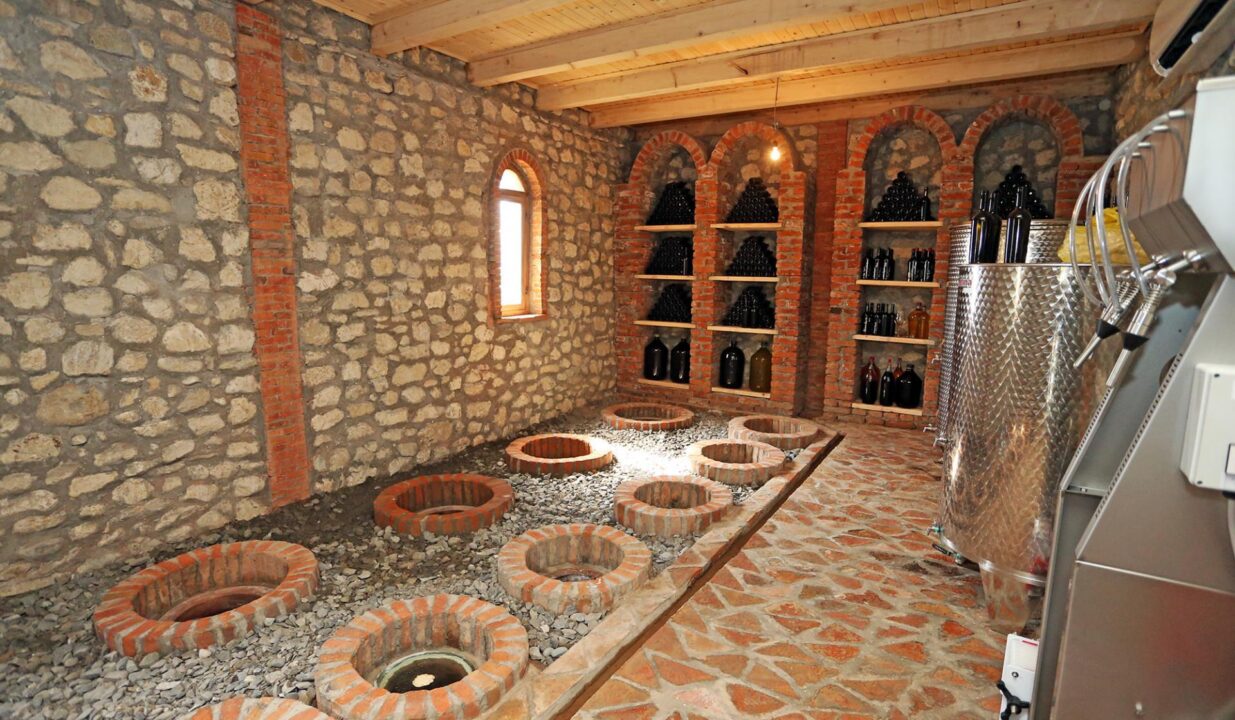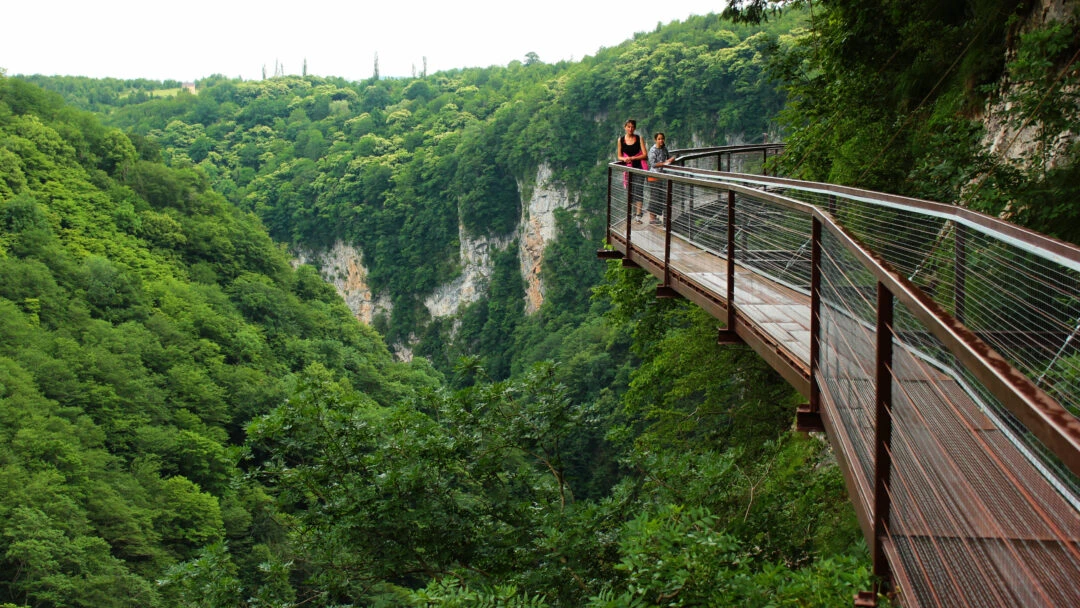Discover Wines of Western Georgia
If you have ever had a conversation about a Georgian wine with a local, you might have heard that we are the birthplace of wine, making the beverage for at least 8,000 years. But this was not proven until almost a year ago, when scientist found a chemical substance on a clay jar during the archeological excavations at Gadachrili Gora and Shulaveris Gora, 50 km away from Tbilisi. This even leads to breaking the Guinness World Record as being the oldest wine-making country on Earth.
Just like the Georgian cuisine, where each region has its own meal, Georgian viniculture spans from east to west, having around 500 different vines. However, over several decades, Kakheti remained the most popular wine region of the country, producing some of the good wines like Rkatsiteli, Khikhvi, Kisi, and Saperavi to name a few. And few of us know that the rest of the country started to revive the viniculture and offer diverse products to wine lovers visiting the country. So without the further ado, here are some of the vines of Western Georgia you need to know and the best place to try them.
Imeretian Grapes

Photo Source: Nline Media
Before talking about the grapes themselves, you need to know a bit more about the Imeretian winemaking method which is slightly different from so-called “Kakhetian”. Here, grapes are pressed in a stumping wine press called Satsnakheli and the grape juice is poured in well-washed qvevri (clay jar) with an addition of destemmed husks of grapes, we call chacha. Afterward, the vessel is sealed and left to ferment. Locals believe that adding chacha helps with fermentation process and accelerates cleaning the wine giving it clear color and more aroma.
Krakhuna

Photo Source: Advantour
This is one of the most distinctive and widespread white wine grape in Imereti. It comes from the village Sviri and is distinguished with a special microzone. Several decades ago, Khrakhuna was on the verge of distinction, but luckily, this has changed and it became quite popular among the winemakers. To produce typical Imeretian, high-quality wine, enterprises combine three types of Imeretian wine – Khrakhuna, Tsitska, and Tsolikouri. They are also used to make Madeira and Port wine. It must be noted that the type of wine depends on the time of vintage, for instance, September vintage creates classic European type, while October vintage is best for traditional Imeretian qvevri wine. And those, who would like to make sweet wine, the winemakers harvest Khrakuna either at the end of October or the beginning of November.
Tsitska
Tsitska is a standard grape big high quality and soft table wine mainly used to make fizzy wines. Vineyards of Tsitska are situated in the villages of Kvaliti, Sviri, Puti and Ilemi, making the wine transparent with strong straw color. When the wine is left for aging, Tsitska becomes gentler and harmonious with a rich fruity bouquet.
Tsolikouri
Similar to Tsitska, Tsolikouri is the best grape to make table wine and semi-sweet white dessert wine. The type of wine made from Tsolikouri also depends on the microzone the vineyard is located. In Upper Imereti, Chiatura and Sachkhere, the grapes have less sugar, while the ones in the Middle of Imereti or Lower, are sweeter.
Otskhanuri Sapere

Photo Source: Agrogate World
This grape is widespread in Sachkhere, Zestaponi, Terjola, Baghdati, and Chiatura areas. The wine made from this grapes makes a high-quality table wine and are characterized with intensive dark-red color, therefore, it is often used to blend with other red and white grapes.
Aladasturi

Photo Source: Advantour
Commonly seen in the middle and lower lands of Imereti, Aladasturi grape makes a high quality, full-bodied semi-sweet red wine with rich aromas.
Megrelian Grapes

Photo Source: Georgian Journal
Samegrelo region has many different grapes to make wine from, but unfortunately, many of them have been lost or are on the verge of extinction. Due to this, there are not many vineyards or wineries concentrating on Megrelian wines. The only widespread grape from the region, whose wine you can try is Ojaleshi. Originally, the grape’s name is Shonuri or Svanuri, but in Samegrelo and rest of the country, everyone knows it with the name Ojaleshi. The vine is quite strong but is characterized with low quantity harvest. The grape has round, black, and thick skin berries. The wine made from Ojaleshi is dark-red color, velvety and has rich aroma and taste.
Where to Try Imeretian and Megrelian Wines

Photo Source: Advantour
The best place to start your Imeretian wine tour is Kutaisi, the second largest city in the country and home to UNESCO World Heritage Sites. If you can spend a couple of days here, you can visit the family-run wine cellars in the villages of Bagdati, Terjola, and Chkhari. Here, you’ll be able to see the vineyards try their types of wine along with local cuisine.
However, if you don’t have much of the time to visit all those cellars, you can easily visit Satsnakheli wine bar in Kutaisi. The very recent addition of dining venues of Kutaisi, Satsnakheli boasts with 120 different types of wines made in Georgia, including local products of the region.
And if you are traveling in Kutaisi, you’re more likely to visit Martvili Canyon as a day-trip. To make your small trip to the canyons even more enjoyable, we recommend visiting a family wine cellar Oda and Vino Martville in the village Targameuli in Martvili Municipality. The owners, Zaza Gagua and his wife Keto Ninidze, moved from Tbilisi to Martvili, at Zaza’s grandparent’s house with the aim to revive Megrelian and Imeretian grapes that are on the verge of extinction or are unknown to the wide audience. They both have their own wine cellar producing different wines with different labels and names, but they have one thing in common – all of their wines are natural, meaning that nothing is added during the making process, everything happens naturally.

Photo Source: Agenda.ge
Vino Martville was founded in 2012 and owns 0.5 ha of Ojaleshi vineyard. They have partner winegrowers in Samegrelo, Imereti, and Lechkhumi regions who grow grapes organically. Therefore, you can try Imeretian, Megrelian, and Rachuli wines in kvevri including Orbeluri Ojaleshi, Khrakhuna, and Dzelshavi. Moreover, they started to revive one of the Abkhazian grapes, but haven’t harvested yet as it’s in small quantities.
Besides tasting wine in a typical Megrelian household with a wooden house and wine-related items decorating the courtyard, you can have a delicious dinner with revived Megrelian meals that has been long forgotten.
It must be noted that like many other family-run wineries, Zaza’s and Keto’s wines are mainly exported to different parts of the world including Australia, Japan, UK, Poland and the USA, leaving them with a few hundred bottles to serve their visitors.
Guruli Grapes

Photo Source: Triptipedia
In the past, viticulture and winemaking in Guria were very well developed with around 60 wine grapes cultivated in the region. Unfortunately, the very recent past of the country had a massive impact on the industry and resulted in the extinction of many grapes. Fortunately, there are a couple of winemakers that look after reviving those indigenous vines. Here are the most common wine grapes found in Guria.
Chkhaveri
This is one of the most widespread vines in Guria characterized with high quantity harvest, dark rose color berries, thin skin, and sweet with a bit of a bitter taste. The wine made from Chkhaveri is of rose color, somewhat sweet with a rich aroma.
Jani
Jani, literally translated as “strength” into English, is one of the revived vines of Guria today. Its berries have thin skin and are of dark black color. If left on the vine for a long time, berries don’t rotten but dry out. The wine made from Jani grapes are dark red color, has a bit of a bubbly effect when tasted, it’s sweet with very balanced acidity and is believed to be one of the best wines of the region.
Mtevandidi
The berries of Mtevandidi are characterized with thin skin, black color, and sweet taste. The wine made from this grape is of dark red color and has well-balanced sweetness, acidity, and aroma. It also ages well, making the wine tastier and rich.
Aladasturi
Similar to Imereti, Guria also cultivated Aladasturi and wine made from it is dark red color, light, with not that rich taste compared to other vines of the region.
Where to Try Gurian Wines

Photo Source: Food Fun Travel
For those of you who like to visit family-run wineries, you need to get to village Bukistsikhe in Chokhatauri Municipality. Teimuraz Sharashidze’s wine cellar is one of the most distinguished one in the area, where you can try wines made from well-known and rare vines of Guria. He has managed to revive 20 different vines but makes wine out of 12 various grapes including Chkhaveri, Jani, Otskhanuri Sapere, Gurian Saperavi, Aladasturi, and Tsolikouri to name a few.
His wine cellar is located in an authentic wooden Gurian house, adorned with local ethnographic household items that his ancestors used back in the day. Besides wine tasting, you can try local, Gurian cuisine, fishing on the river Supsa, horse riding, and even stay at their guest house.
We created Memo — a brand where Georgian memories come to life.
Visit Memo By GSH and take a piece of Georgia with you – Www.memories.ge







